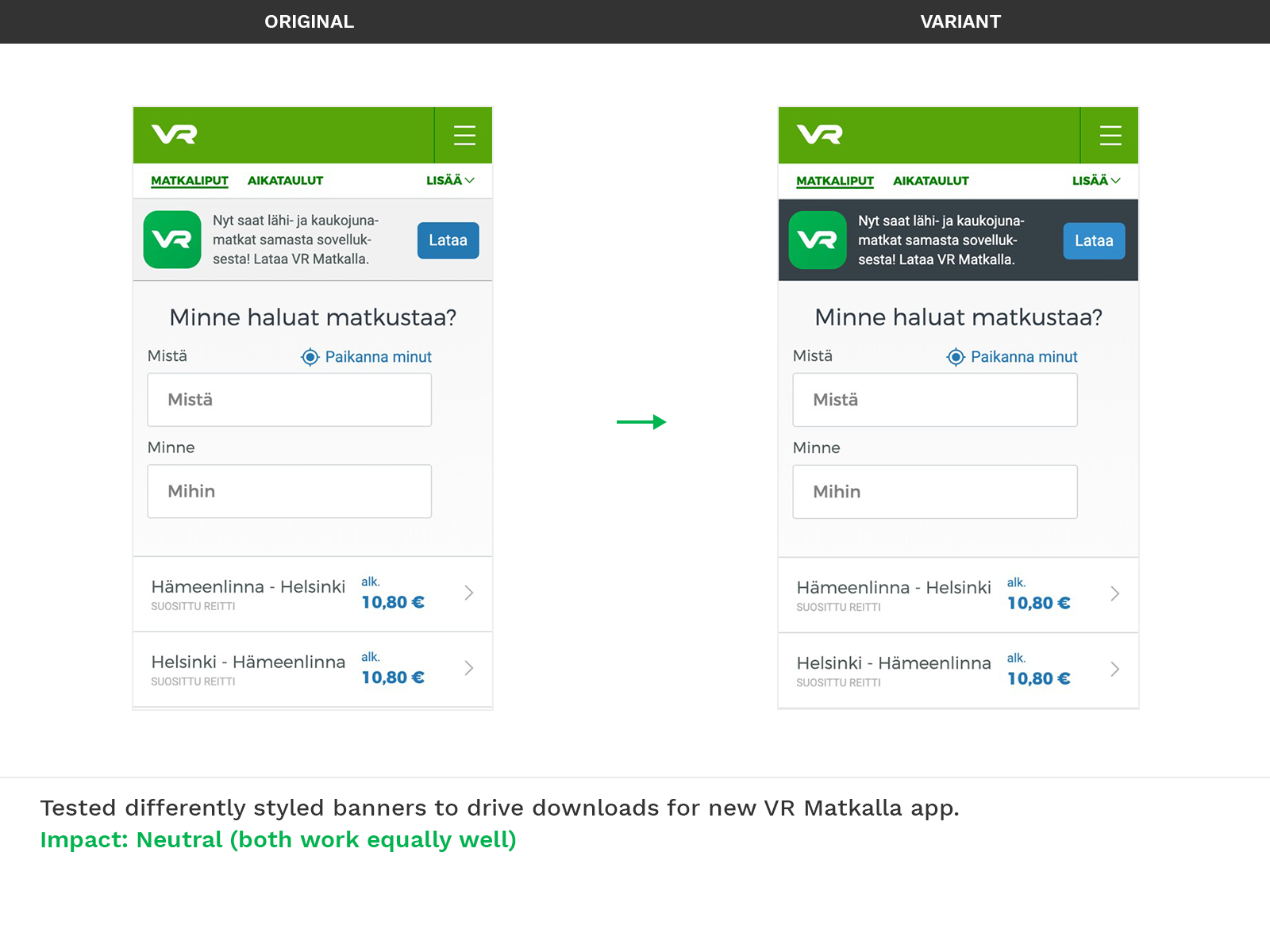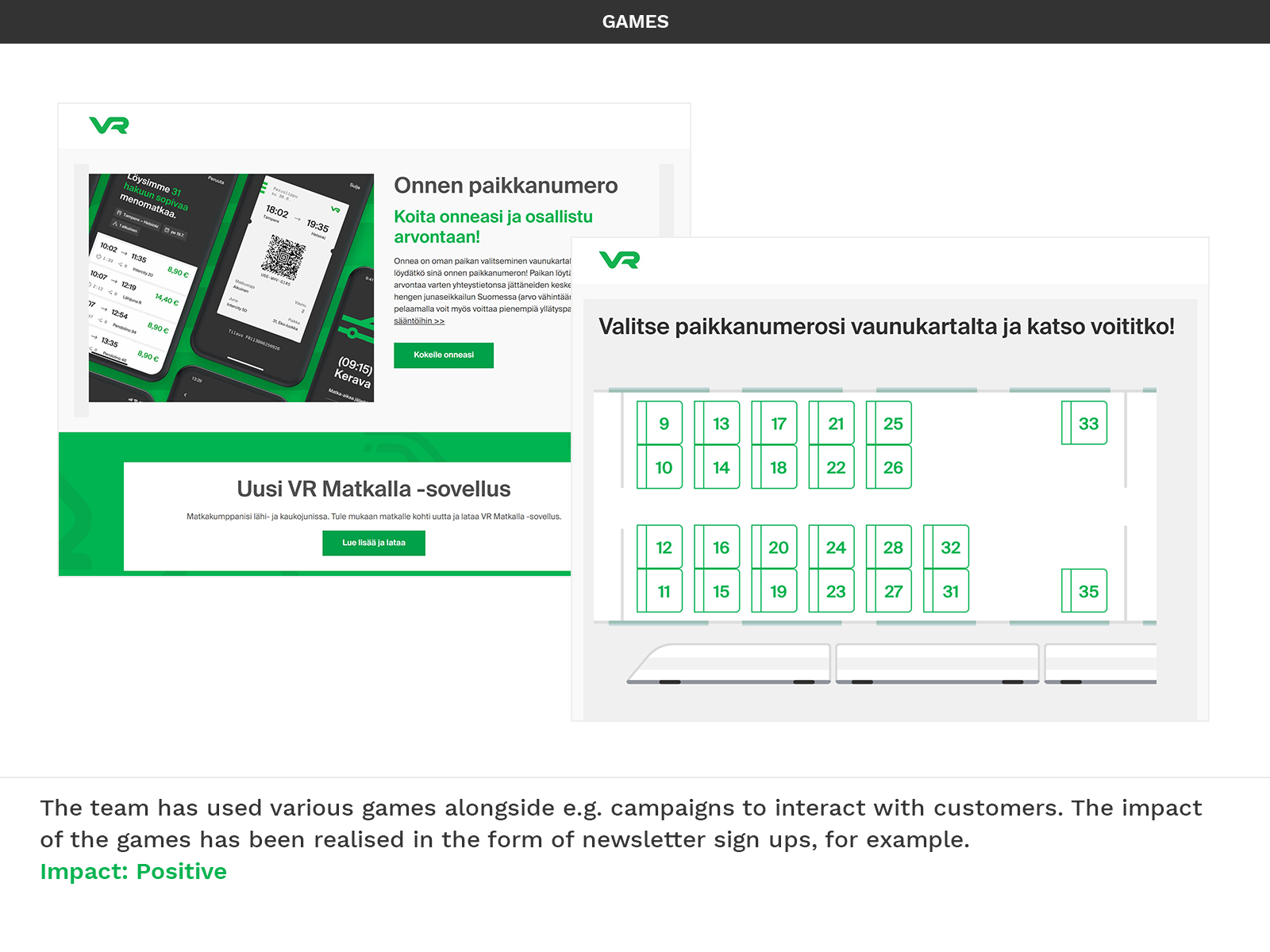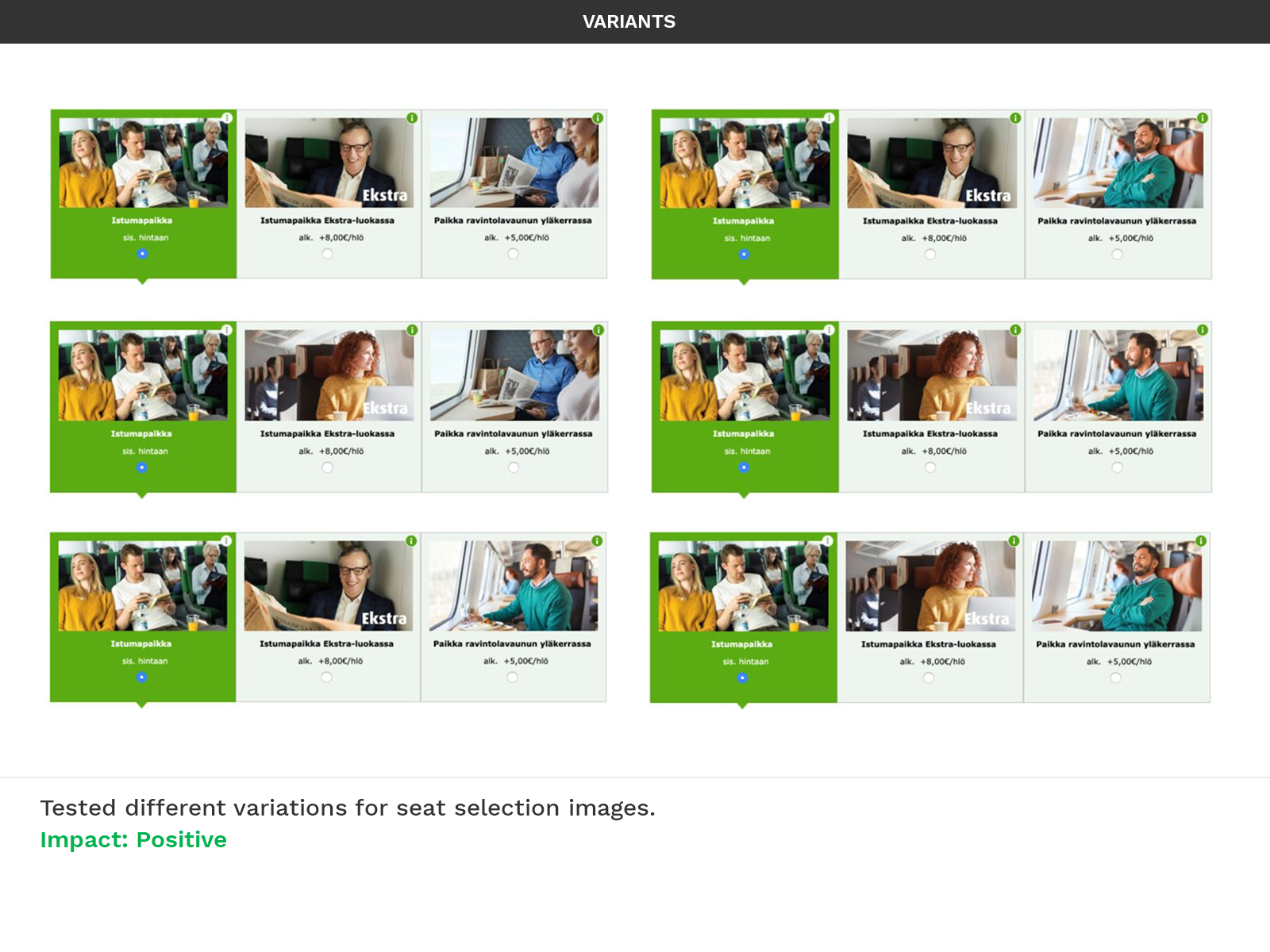VR Group
VR Group is a diversified, environmentally friendly and responsible service company operating in the field of travel and logistics. VR Group is owned entirely by the Finnish state.
WebsiteVR had conducted a pre-study project with the purpose of finding ways to improve its digital sales capabilities and effectiveness further. As a way forward, VR started running digital sales through a Growth Team approach.
Key objectives
While the organisation had already been able to seize forms of advanced thinking, plans and activities, VR acknowledged that these activities were often scattered into separate teams and organisational silos and that the cooperation between different units was insufficient. Partial optimisation of units was considered to carry a risk of suboptimal sales results. At that point, many sales were based on campaigns and price-driven messages, less on continuous optimisation and customer value.
However, since the importance of customer experience was growing to be the primary focus of VR, it was important to align various digital channels and customer interfaces to allow customer experience to meet expectations consistently across all touchpoints. VR decided to reorganise smaller units back into the core organisation to create a more coherent entity that can operate smarter.
We have learned to pursue growth in a data-driven and systematic manner. It has been a continuous learning process to build competence and shared ways of working, and a pleasure to see that the work has paid off in the form of good business results.
Ilona Pirhonen, VR, Digital Growth Lead
Our Approach
Strategy
This reorganisation at VR also enabled the emergence of a Growth Team. From a sales perspective, the main strategy to work on the insights gathered in the pre-study was to start leading online sales more consistently.
First, it was clear that the different parties responsible for customer experience in the various touchpoints should have a shared vision of the desired customer experience and the objectives and metrics that communicate how well the goal is being fulfilled.
Then, it was agreed that there should be a cross-organisational team with the mandate to improve the customer experience and sales in any part of the sales funnel by experimenting with new ideas rapidly and continuously. This also meant that in addition to building new solutions and channels, there was now a conscious move towards improving old channels and continuous optimisation.
The Growth Team would take on the responsibility of ideating, prioritising, planning, improving and analysing the sales funnel independently of other development activities and rigid processes taking place in the organisation. And finally, the team’s goal was set to be always on continuous business growth through constant improvements rather than one-off hacks or quick tricks.
Solution: A Growth Team
The Growth Team is a cross-disciplinary team consisting of people from both VR and Columbia Road. The Growth Team operates as an independent unit focusing only on implementing growth experiments, from initial ideas to the final analysis. The key metric that the team follows is the increase of online sales: by improving conversion rate and average order value and by driving more traffic to VR’s digital channels (web and mobile).
In addition to pure sales, the team shares learnings and examples with the rest of VR regarding ways of working, best practices, experimentation culture, customer feedback as well as solutions that could be applied and repurposed somewhere else in the organisation.
The role of Columbia Road is best described through the following activities and responsibilities, most of which were often handled together with team members from VR:
- Creating new growth hypotheses by using data from various sources
- Planning and implementing A/B tests and growth experiments
- Analysing the impact and results of the tests
- Designing improvements in the user experience (UX) and the user interface (UI) of websites and mobile applications, as well as designing completely new features in these channels
- Designing and implementing new landing pages
- Identifying new growth opportunities by analysing data
- Implementing new data collection tags to capture relevant data for analysis
- Conducting user surveys to understand user needs and expectations better
- Facilitating the process by which the team operates
- Working closely with key stakeholders (e.g. product teams, marketing, and pricing) to be able to address their needs as well as scale improvements in a wider manner
Finally, the original prestudy outlining the opportunities and relevant actions regarding how to run digital sales through a dedicated growth team was conducted by Columbia Road.
Processes
The team operates in growth sprints that last two weeks. The content of the sprint is chosen from a prioritised growth backlog (managed by the Growth lead and Growth owner). The key steps in the process are data analysis and growth opportunity identification, experiment ideation, prioritisation, planning, implementation, data gathering and analysis. At the end of the sprint, the team organises a review session where new insights, findings and results are demonstrated to a broader audience. The scope of the Growth Team’s work is all VR digital channels (websites, mobile apps, external landing pages and tools), including social media and email, and all products and services sold in those channels.
Methods and tools
A/B tests: The primary growth engine at VR are A/B tests and growth experiments. In 2019 the team completed more than 100 A/B tests in web and mobile channels.
Content and tools: When needed, the team has also addressed urgent content needs with custom landing pages, features on the site (such as renewed station and network map, and new functionalities to ticket purchase funnel) and tools such as a CO2 emission calculator. The purpose of these activities has been to provide relevant information to customers and address their emerging needs and expectations faster than would otherwise be possible.
Marketing and messaging: In addition to tests and tools, the Growth Team created four campaigns outside VR’s yearly campaign, and marketing plan—these campaigns were more tactical in nature and were devised to capture specific audiences at specific times, e.g. Valentine’s day car train campaign.
Data analysis: The team is constantly analysing test results and identifying new growth opportunities. In 2019 the team, for example, conducted brief surveys, analysed chat transcripts and conducted various sales funnel analyses.
Growth experiments
There are many different types of experiments among the 100+ A/B tests completed in 2019. The team’s tests typically range from changing existing copy, labels and colours to creating new elements that support the user's journey. Also, personalisations and changes in imagery have been used. The experiments implemented to the purchase funnels, as portrayed in the screenshots, are good examples of typical A/B tests.
In 2019 the Growth Team deployed four custom landing pages, which were designed to steer VR’s value proposition away from price-driven messaging and more towards values such as climate-consciousness, safety and enjoyment of train travel, as well as capture families’ unique needs related to travelling. Additionally, a site called uudistuu.vr.fi was created to introduce new channels and to drive traffic to those channels. Also, replacing a static network and station map with an interactive version led to increased organic search traffic and had a positive business impact.
Different contextual messages and banners have been used to promote the new app and its novel functionalities. The Growth Team has deployed these messages in relevant places across channels to drive app downloads. Finally, the team has used various games alongside, for example, campaigns to interact with customers.



Results
| Overview (2018-2019) | Visits with Experiments (2019) |
|
5.36% conversion rate on vr.fi 14.92% car train revenue on vr.fi |
23.76% conversion rate on vr.fi 41.12% car train conversion rate on vr.fi |
App Downloads55 000 app downloads from the growth team's banners and links 20% of total app downloads from the growth team's banners and links |
Project100+ A/B tests completed in 2019 Four custom landing pages designed to steer VR’s value proposition away from price-driven messaging and more towards value-driven Scope all products and all digital channels (incl. social media and email) |
The Data Handbook
How to use data to improve your customer journey and get better business outcomes in digital sales. Interviews, use cases, and deep-dives.
Get the book


